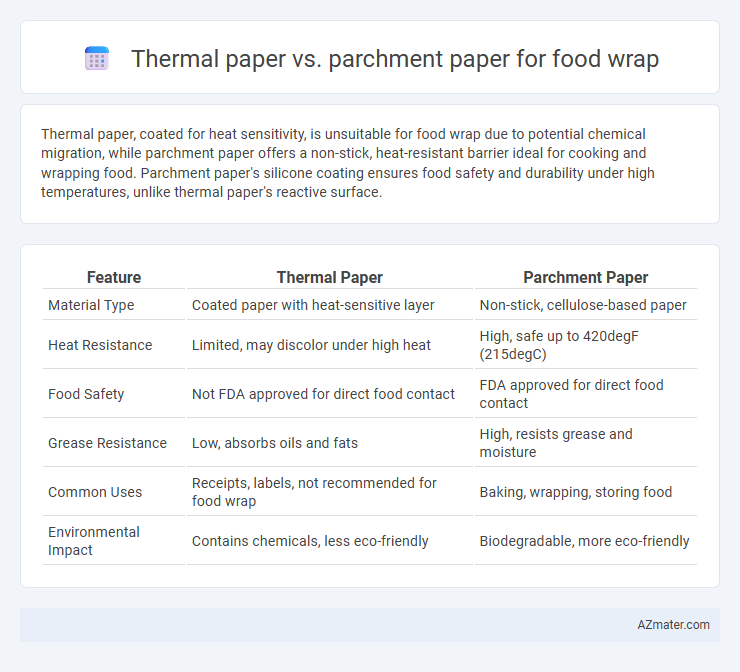Thermal paper, coated for heat sensitivity, is unsuitable for food wrap due to potential chemical migration, while parchment paper offers a non-stick, heat-resistant barrier ideal for cooking and wrapping food. Parchment paper's silicone coating ensures food safety and durability under high temperatures, unlike thermal paper's reactive surface.
Table of Comparison
| Feature | Thermal Paper | Parchment Paper |
|---|---|---|
| Material Type | Coated paper with heat-sensitive layer | Non-stick, cellulose-based paper |
| Heat Resistance | Limited, may discolor under high heat | High, safe up to 420degF (215degC) |
| Food Safety | Not FDA approved for direct food contact | FDA approved for direct food contact |
| Grease Resistance | Low, absorbs oils and fats | High, resists grease and moisture |
| Common Uses | Receipts, labels, not recommended for food wrap | Baking, wrapping, storing food |
| Environmental Impact | Contains chemicals, less eco-friendly | Biodegradable, more eco-friendly |
Introduction to Food Wrapping Materials
Thermal paper and parchment paper serve distinct roles in food wrapping, with thermal paper primarily used for printing receipts rather than direct food contact, while parchment paper offers heat resistance and non-stick properties ideal for cooking and food wrapping. Parchment paper, often silicone-coated, provides a safe barrier against moisture and grease, making it suitable for wrapping baked goods and greasy foods. Thermal paper, coated with chemicals for heat-sensitive printing, is generally not recommended for food wrapping due to potential chemical transfer and lack of heat resistance.
What is Thermal Paper?
Thermal paper is a specialized paper coated with chemicals that change color when exposed to heat, commonly used in receipts and labels rather than for food wrapping. Unlike parchment paper, thermal paper is not designed for cooking or direct food contact and may contain chemicals unsuitable for food safety. Its heat-sensitive properties make it ideal for printers but limit its use in food preservation or preparation.
What is Parchment Paper?
Parchment paper is a heat-resistant, non-stick paper commonly used in cooking and baking to prevent food from sticking and to facilitate even cooking. It is coated with silicone, making it moisture-resistant and ideal for wrapping foods, especially those that require baking or reheating. Unlike thermal paper, which is designed for printing receipts and can contain chemicals unsuitable for food contact, parchment paper is safe and specifically intended for food wrapping and preparation.
Food Safety: Thermal vs Parchment Paper
Thermal paper is not suitable for food wrap due to its chemical coating, which can transfer harmful substances to food, posing health risks. Parchment paper, made from cellulose with a non-toxic silicone coating, is food-safe and ideal for wrapping and cooking food as it resists heat and moisture without chemical contamination. Choosing parchment paper over thermal paper ensures compliance with food safety standards and reduces the risk of chemical leaching into edible items.
Heat Resistance Comparison
Thermal paper, primarily designed for printing receipts, has limited heat resistance and can warp or discolor when exposed to high temperatures above 250degF (121degC). Parchment paper exhibits superior heat resistance, typically withstanding temperatures up to 420degF (215degC), making it ideal for cooking and food wrapping under heat exposure. For food wrap applications requiring high-temperature exposure, parchment paper offers a safer and more durable heat-resistant solution compared to thermal paper.
Chemical Composition and Food Contact
Thermal paper contains a coating of dye and developer chemicals that react under heat to display images, making it unsuitable for direct food contact due to potential chemical migration. Parchment paper is typically treated with silicone, creating a non-stick, heat-resistant surface that is food-safe and commonly used in cooking and food wrapping without the risk of harmful chemical transfer. The chemical composition of parchment paper ensures its inertness and compliance with food safety standards, contrasting with the reactive chemicals in thermal paper that can pose health risks if used for food packaging.
Practical Uses in Food Wrapping
Thermal paper is primarily used for receipts and is not suitable for direct food wrapping due to its chemical coatings that can transfer harmful substances. Parchment paper, coated with silicone, offers a non-stick, heat-resistant surface ideal for wrapping foods, baking, and preserving freshness without chemical contamination. It ensures food safety, moisture retention, and ease of handling, making it the preferred choice for cooking and food storage applications.
Environmental Impact and Sustainability
Thermal paper contains chemical coatings like BPA or BPS that pose environmental hazards during production and disposal, contributing to pollution and landfill waste. Parchment paper, often compostable and made from sustainably sourced cellulose, offers a more eco-friendly alternative that breaks down more easily without releasing harmful substances. Choosing parchment paper over thermal paper significantly reduces environmental footprint and supports sustainable food packaging practices.
Cost Effectiveness and Availability
Thermal paper is generally less expensive and widely available, making it a cost-effective option for short-term food wrapping but lacks heat resistance and moisture durability. Parchment paper, while pricier and sometimes less accessible in bulk, offers superior heat tolerance and non-stick properties, enhancing food quality during baking or reheating. Evaluating based on application requirements, parchment paper justifies its higher cost for heat-related uses, whereas thermal paper suits cold or dry wrapping needs due to its affordability and broader availability.
Conclusion: Best Choice for Food Wrapping
Parchment paper is the best choice for food wrapping due to its non-toxic, food-safe coating and high heat resistance, ensuring food stays fresh without chemical leaching. Thermal paper, primarily designed for printing receipts, contains chemicals like BPA or BPS that can contaminate food and is not heat-resistant, making it unsuitable for direct food contact. For safe, effective food wrapping, parchment paper offers superior protection and compliance with food safety standards.

Infographic: Thermal paper vs Parchment paper for Food wrap
 azmater.com
azmater.com